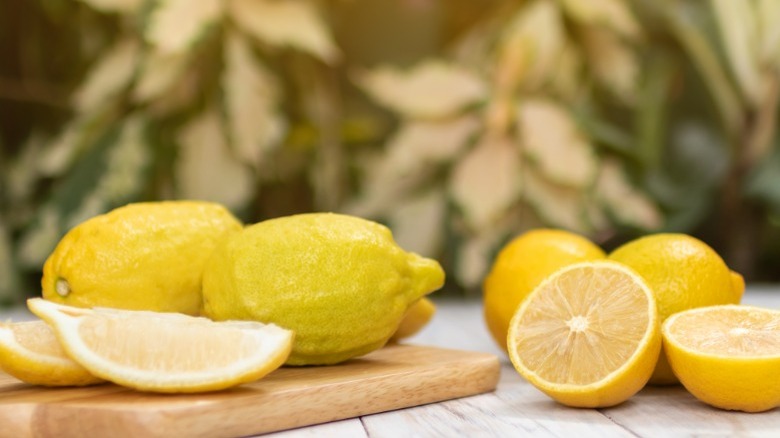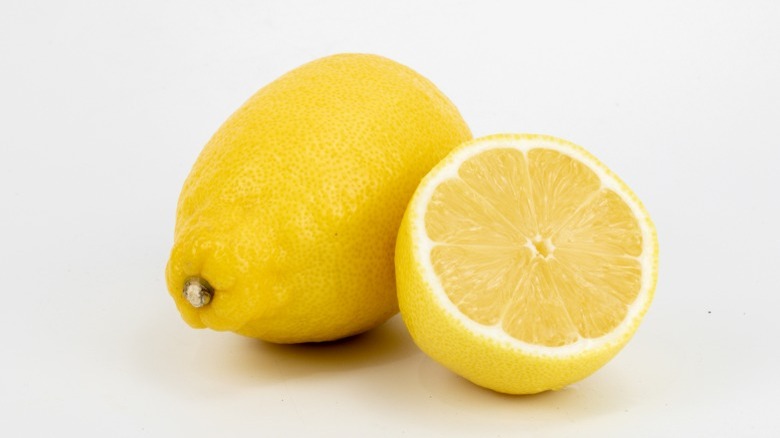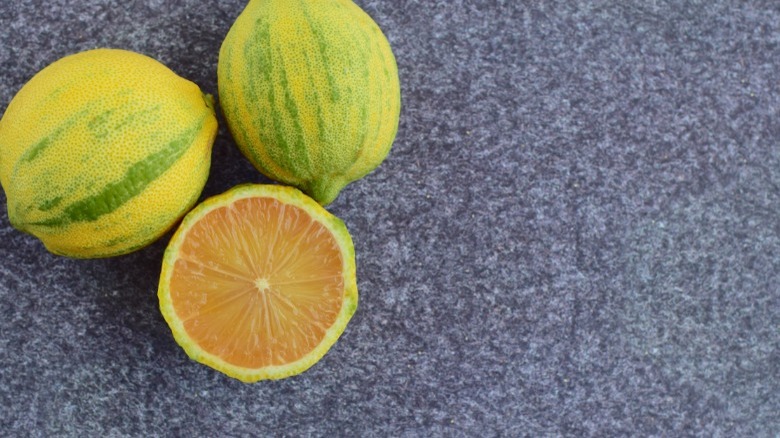14 Varieties Of Lemons, Explained
You just can't say enough good things about lemons. Not only are they a healthy fruit used in countless food and drink recipes, they're also great for cleaning and medicinal purposes. Lemons belong to the Rutaceae genus of plants and, believe it or not, they are human-made creations. Lemons did not come to planet Earth on their own — instead, they're the result of cross-breeding bitter oranges and citrons. Lemons were first seen in East Asia and later found their way to the rest of the world: For example, when Christopher Columbus came to America, he brought lemon seeds. Nowadays, there are more than 30 varieties.
Lemons grow on bushes and small trees, which belong to the Rue (Rutaceae) plant family. Limes and oranges also belong to the Rue family, and with all the different varieties of different fruits, it can be hard to know what is what. For instance, some lemons have green or orange skins. Some even have stripes.
You won't find all the lemon varieties below at the local Acme, but less common ones can often be purchased at specialty grocery stores and farmers markets. Another option is to order the trees and bushes online and grow them at home if you live in the right climate. Lemon trees do best in USDA hardiness zones 8 to 11, but can be grown in containers in zone 7. Here are 14 varieties of well- and lesser-known lemons.
Lisbon lemons
The Lisbon lemon is one of the most common kinds seen in U.S. grocery store produce sections, and is known as a true lemon because it is acidic and juicy. The first Lisbon lemon seeds appeared in 1917 and the variety was introduced in 1950, and it's now one of the most common varieties cultivated in California. The outsides of Lisbon lemons are yellow and somewhat textured when ripe, with pale, greenish-yellow flesh inside.
You can differentiate these lemons from other varieties in stores by their large nipples (known as apical mammilla). Lemon nipples are opposite the stem ends and are basically protrusions of the rinds. Some are flatter while others are larger; they are a good way to determine what kind of lemon you're looking at. There are seeded and seedless varieties of Lisbon lemons, and some common uses for them are on roasted chicken, in cream-based sauces, and in seafood.
Meyer lemons
A USDA employee named Frank Meyer found Meyer lemons growing in China more than 100 years ago and brought clippings back to the U.S. The legend has it that even though Mr. Meyer was told the trees were for decorative purposes only, he persisted in growing them for the fruit — and now we have these cool, slightly sweet little lemons.
Similar to the Lisbon variety, Meyer lemons are rounder and have a milder taste. Meyer lemons have an orangeish-yellow color when fully ripe, with less distinguishable nipples than Lisbons. They also have thinner skins than other lemons, and the skin is actually edible. The juice is less acidic, and that orangeish color is telling us something: The flavor tastes like a combination of both lemons and oranges. Since the Meyer lemon's taste isn't overly sour, it can be eaten raw; it's also a common addition to fruit salads and can add flavor to cheesecakes, risotto, and mojitos.
Seedless lemons
It's impossible to tell whether or not a lemon has seeds (pips) inside unless it's cut open. Seedless varieties look and taste just like traditional lemons, so the only way to tell them apart is through their packaging; they are generally sold in labeled bags. And while you might pay more for seedless lemons, you won't have to pick out those annoying little pips by hand.
The first of these were grown in Australia after a farmer found a single lemon tree with seedless fruit. A sample of one of these naturally mutated varieties was brought to America by the U.S. Department of Agriculture, but seedless lemons haven't caught on until relatively recently. Seeded, standard lemons like Lisbon are hard to crossbreed, for one thing. California growers started growing these trees nearly 30 years ago, and while they still aren't taking off with consumers quite yet, some produce companies like Wonderful Citrus are trying to make seedless lemons happen in a big way. You can often find seedless mandarin oranges, so perhaps seedless lemons will soon be just as common.
Millsweet limetta
Also known as Mediterranean sweet lemon, Millsweet Limetta comes from India and the Mediterranean. It's sweet enough to eat like an apple, and the peel contains lots of lemon essential oil. Millsweets have slightly recessed, protruding greenish-yellow nipples, and are also known as citrus medica var limetta or mosambi. This variety is widely used in Mexican and Asian cooking.
This fruit is a cultivar of sweet lime, with a sweet taste and high vitamin C content. The medium-sized limetta has a flattened bottom, and is yellowish-orange on the outside when ripe. The inside flesh has few seeds and is pale yellow in color. The Millsweet limetta has no acidic content at all, but not all limettas are sweet; for instance, the Limonette de Marrakech is highly acidic. This is an uncommon citrus fruit that you don't see every day, but we found one of the small trees on eBay, priced at $15.98.
Verna lemon
An excellent juicing lemon, Verna lemons are the fifth most popular variety in the world, and the second most popular in Spain after the Primofiori. The Verna sports a bright yellow, sort of fluorescent color, and has an elongated shape and a pointed end. These large lemons have thin, smooth skin and tender flesh that produces a lot of juice but not too many seeds. It's low in acidity, with a tart/sweet flavor profile. Another reason for the Verna's popularity is its bloom time. Verna lemon trees actually have two bloom seasons, the primary of which lasts the whole summer long (the quality of the second bloom isn't as high, however).
Verna lemons have wrinkly rinds, pronounced necks at their bases, and large apical mammilla. Snature Citrus & Stone Fruits claims that Verna lemon juice reduces stomach pains when taken with sugar and water, and is also used to whiten nails and exfoliate the skin. But if you're more interested in delicious recipes, Verna is a good lemon to use in sponge cakes and lemon rolls.
Primofiori lemon
Also from Spain — and the most popular lemon in that country — Primofiori lemons aren't as large as Vernas. It a neckless fruit that is oval in shape, and it also goes by the names Blanco and Mesero. It has a small, pointed mammilla and contains 25% juice. Primofiori lemons also have a decent number of seeds, and high acidity. The Primofiori lemon tree's leaves are larger than the ones on Verna lemon trees, and are also thorny.
These lemons will keep up to 15 days at room temperature or can last up to three weeks in the fridge. Once cut, Primofioris should be used quickly because the open ends will dry out after a few days. It's a newer species and is more on the more acidic side. People who like sweet and sour dishes like Mandarin chicken might find an abundance of uses for Primofiori lemons.
Sorrento lemon
As the name would suggest, Sorrento lemons originated in Italy's Sorrento peninsula. Their cultivation can be traced back to the 16th century, and the fruit is used to make appetizers, entrees, side dishes, desserts, and limoncello. Varieties of Sorrento lemons include the PGI and Sorrento femminiello (Massa). Sorrento lemons have medium-thick, citrine-yellow rinds, and strong, citrusy smells.
Sorrento lemons have plump, oval shapes that taper gently toward the sides. The glossy rinds, which range from yellow with smudges of green to bright golden yellow, have a lot of oil glands and noticeably bumpy surfaces. The stem end is on the flatter side, and the mammilla is pointed. Sorrento lemons have semi-transparent pale yellow flesh, thick white pith, and minimal seeds. These lemons have a uniquely zesty flavor with a hint of sweetness. They're great when you need to add moderate acidity to soups and curries, and can also be roasted with meats and poultry.
Genoa lemon
Here is another popular Italian lemon that's also used to make limoncello: the Genoa. This wide, round variety has a vibrant color but doesn't produce a lot of juice. Genoa lemons are closely related to Eurekas, and the trees arrived in the U.S. in 1875. It is one of the main kinds of lemons grown in Chile and Argentina. The fruits are larger and rounder than Lisbon and Eureka varieties, and the thin rinds can be smooth or coarse. The number of seeds found inside varies from zero to six.
Four Winds Growers sells a semi-dwarf Genoa lemon tree for $50 and claims that the rind's high oil content makes it work well in recipes that call for lemon zest and tartness. Genoa lemons are also used in limoncello recipes. Genoa lemon trees produce their greenish-yellow fruit all summer long, and the plants can be grown in containers as long as they are protected from frost.
Lamas lemon
Grown in Turkey, Lamas lemons are medium-sized and usually have no more than five seeds. Lamas have an elongated shape and a yellow or light greenish, glossy, medium-thick rind. These lemons also have rounded necks and obvious mammilla, and their juice level is almost 35%. The peak harvest season for these Turkish lemons spans from July through October, but they are grown year-round in their native country due to the optimal climate.
Lamas lemons pair beautifully with foods like Lahmacun (Turkish pizza). To get the most out of your Lamas lemons (though this tip can apply to most any lemons), zest them first and save that in an airtight container unless you plan to use them right away. Otherwise, the lemon will quickly dry out. Lemons give more juice when they're at room temperature, and if you have extra, just pour it into ice cube trays and stick them in the freezer.
Eureka lemon
The Eureka lemon is commonly found in grocery stores, and is an iconic and easily recognizable variety with a noticeably bright yellow rind. Eureka is the most popular lemon in California, Australia, and Israel, and its varieties include Lambert and Taylor. The rind is greenish-yellow, with a thin to medium thickness. The shape ranges from elliptical to oblong, with short necks and medium-sized mammilla. This average-sized lemon contains zero to five seeds.
The origin of the Eureka lemon dates back to the late 1800s, when Thomas Garey visited Italy and brought Lunario lemon seeds back to California. These were the start of what eventually became Garey's Eureka lemon trees, one of the fastest-growing citrus tree varieties out there. This is a delightfully sour, juicy variety of lemon that is sold loose, but you usually don't pay by the pound. When it's in season and on sale, you can probably pick up five of them for a dollar or two. Eureka lemons also make a tartly refreshing lemonade – as long as you add enough sugar to balance out the acidity.
Variegated Eureka lemon
We had to add the variegated Eureka lemon to the list because it's a lemon disguised as an itty-bitty watermelon, with rose-hued flesh that's reminiscent of grapefruit and a cool yellow-and-green-striped rind. This lemon was not created on purpose; like the first seedless lemons, the variegated Eureka resulted from a spontaneous mutation found in 1931 in Burbank, California. But the juice isn't pink; it's clear, just like the juice from more traditional lemons. Variegated Eurekas are also on the rounder side, and fit right into the palm of your hand.
These lemons aren't as sour as regular Eurekas, so they're perfect in desserts like lemon meringue pie. And as they ripen, the flesh becomes even sweeter and more floral as the pink color deepens, the outer stripes fade, and the rind becomes yellow. Pink Eurekas also have fewer seeds than their yellow cousins, and are therefore just perfect for making pink lemonade (even though you may need to add food coloring since the juice is clear).
Perrine lemon
Perrine lemons are also called Perrine lemon limes because they are hybridizations of Genoa lemons and West Indian limes. But this lemon has a rocky history. It was introduced to the Florida Horticultural Society by Dr. Henry Perrine in 1931, and its taste and appearance were well-reviewed. It was planted in southern Florida, but proved not to be cold-tolerant. The Perrine never turned into a major market lemon, but Perrine had better success with one of his other subjects: the key lime.
This lemon is round like Meyer varieties and has a bit of lime flavor. The rinds are lumpy, tough, and glossy; they turn golden-yellow when ripe, and have prominent oil glands on the outer skin. The flesh is pale yellow-green and can contain a few or many seeds. The shape is bulbous in the middle, narrowing slightly to a non-stem end and a small mammilla. The pretty Perrine has a high acidity content and a unique lemon-lime flavor. They're harder to find, but one of the best things about Perrines is that they can also be used in recipes that call for lime juice.
Assam lemon
The greenish, elongated Assam lemons hail from Assam, a state in India. The two most popular varieties of Assam are Kaji Nemu and Gol Nemu, and neither looks like the typical lemon. The seedless Kaji Namu is on the longer side, and you might think it's a cucumber at first glance. Gol Nemu is smaller and rounder and turns yellow when it ripens; it's also sweeter.
Kaji Namus are traditionally used in Assamese cuisine because they are juicy, have long shelf lives, and contain no seeds. You may start to see Assam lemons more often in the coming years because they seem to be going global. Assam lemons are a kitchen staple in that part of the world, and people even eat the rinds. The Kaji Namu is three times the size of the Gol Nemu and has been exported to London. Keep your eyes open: Manash Kalita, the CEO of Nilachal Agro Producer Company, stated that marketing and selling efforts for Assam lemons are going to be expanded, via The Print.
Volkamer lemon
The Volkamer lemon variety is named after German botanist Christophe Volkamer (dec. 1720). They have been cultivated for three centuries, and it's theorized by some that Volkamer lemons originated in Italy.
Volkamer lemons are a cross between a citron and a sour mandarin orange, which explains a lot about how they look and taste. They run medium-to-large, are on the rounder side, and have plenty of seeds — more than many other lemon varieties. The outside color starts out green and can range from dark yellow to orangey as the fruit ripens; the skin is rich in essential oils. The inside flesh is light orange. The size and shape is similar to classic lemons like Eurekas, and they're used in the same ways — which is to say, the taste will make your mouth pucker. This juicy hybrid is sour and pairs well with honey in Thai food.














